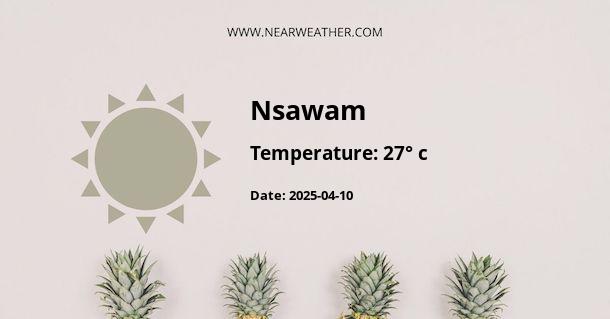Climate and Weather in Nsawam, Ghana
Nsawam is a town located in the Eastern Region of Ghana. It is known for its diverse climate and weather patterns throughout the year. In this article, we will explore the different seasons, temperatures, rainfall, and other weather-related factors that define Nsawam's climate.
Seasons
Nsawam experiences two main seasons: the wet season and the dry season. These seasons are influenced by the tropical climate of the region.
The wet season in Nsawam typically lasts from April to October. During this period, the town receives a significant amount of rainfall, with the highest precipitation occurring between June and September. The wet season is characterized by frequent showers, thunderstorms, and occasional heavy downpours.
The dry season in Nsawam usually starts in November and lasts until March. This season is marked by little to no rainfall, and the weather is generally sunny and dry. However, occasional harmattan winds from the Sahara Desert can bring dry and dusty conditions to the area.
Temperatures
Throughout the year, Nsawam experiences relatively high temperatures due to its proximity to the equator. The average annual temperature in Nsawam is around 27 degrees Celsius (81 degrees Fahrenheit).
During the wet season, temperatures in Nsawam range from 24 to 30 degrees Celsius (75 to 86 degrees Fahrenheit). The humidity levels are also high during this season, making the weather feel hotter than it actually is.
In contrast, the dry season brings slightly cooler temperatures to Nsawam, with average highs of around 29 degrees Celsius (84 degrees Fahrenheit). However, it is important to note that the harmattan winds during this season can cause a drop in temperatures, especially during the early mornings and nights.
Rainfall
Rainfall is an essential component of Nsawam's climate. The town receives an average annual rainfall of about 1,500 millimeters (59 inches).
The wettest months in Nsawam are usually June, July, and August, with precipitation levels peaking during this period. In these months, the town can receive over 200 millimeters (8 inches) of rainfall per month.
On the other hand, the dry season is characterized by significantly reduced rainfall. During this period, Nsawam receives less than 50 millimeters (2 inches) of rainfall per month, if any at all.
Weather Hazards
While Nsawam generally enjoys a pleasant climate, there are a few weather hazards that can affect the area.
One of the most significant weather hazards in Nsawam is flooding, especially during the wet season. The heavy rainfall can cause rivers to overflow and low-lying areas to become waterlogged. It is important for residents and visitors to be aware of the flood-prone areas and take necessary precautions.
Another weather hazard that Nsawam experiences is the harmattan winds during the dry season. These winds can bring dry and dusty conditions, reducing visibility and causing discomfort. It is advisable to stay hydrated and protect oneself from the dusty conditions during this period.
Conclusion
Nsawam, Ghana, has a diverse climate with a wet season and a dry season. The wet season lasts from April to October and brings frequent rainfall, while the dry season lasts from November to March, with little to no rainfall. The temperatures in Nsawam are generally high throughout the year, with the average annual temperature being around 27 degrees Celsius (81 degrees Fahrenheit). It is important to be aware of the weather hazards such as flooding and harmattan winds that can affect the area. Overall, Nsawam's climate offers a mix of warmth, rainfall, and occasional dry periods, making it an interesting place to experience different weather patterns.
A - Nsawam's Latitude is 5.808930 & Longitude is -0.350260.
A - Weather in Nsawam is 27° today.
A - Climate Conditions in Nsawam shows overcast clouds today.
A - Humidity in Nsawam is 83% today.
A - Wind speed in Nsawam is 12.6 km/h, flowing at 192° wind direction. today.
